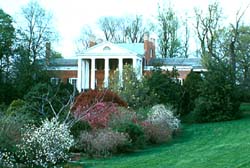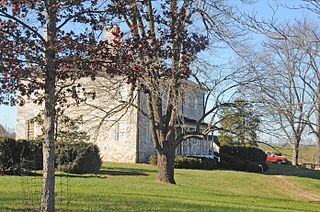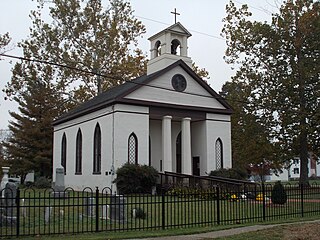
Oak Hill is a mansion and plantation located in Aldie, Virginia that was for 22 years a home of Founding Father James Monroe, the fifth U.S. President. It is located approximately 9 miles (14 km) south of Leesburg on U.S. Route 15, in an unincorporated area of Loudoun County, Virginia. Its entrance is 10,300 feet (3,100 m) north of Gilberts Corner, the intersection of 15 with U.S. Route 50. It is a National Historic Landmark, but privately owned and not open to the public.

Westover Plantation is a historic colonial tidewater plantation located on the north bank of the James River in Charles City County, Virginia. Established in c. 1730–1750, it is the homestead of the Byrd family of Virginia. State Route 5, a scenic byway, runs east–west to the north of the plantation, connecting the independent cities of Richmond and Williamsburg.

Waterford is a unique place of historic significance. The entire village and surrounding countryside is a National Historic Landmark District, noted for its well-preserved 18th and 19th-century character. It is an unincorporated village and census-designated place (CDP) in the Catoctin Valley of Loudoun County, Virginia, located along Catoctin Creek. Waterford is 47 miles (76 km) northwest of Washington, D.C., and 7 miles (11 km) northwest of Leesburg.

Green Springs National Historic Landmark District is a national historic district in Louisa County, Virginia noted for its concentration of fine rural manor houses and related buildings in an intact agricultural landscape. The district comprises 14,000 acres (5,700 ha) of fertile land, contrasting with the more typical poor soil and scrub pinelands surrounding it.

Woodlawn is a historic house located in Fairfax County, Virginia. Originally a part of Mount Vernon, George Washington's historic plantation estate, it was subdivided in the 19th century by abolitionists to demonstrate the viability of a free labor system. The address is now 9000 Richmond Highway, Alexandria, Virginia, but due to expansion of Fort Belvoir and reconstruction of historic Route 1, access is via Woodlawn Road slightly south of Jeff Todd Way/State Route 235. The house is a designated National Historic Landmark, primarily for its association with the Washington family, but also for the role it played in the historic preservation movement. It is now a museum property owned and managed by the National Trust for Historic Preservation.

Oatlands Historic House and Gardens is an estate located in Leesburg, Virginia, United States. Oatlands is operated by the National Trust for Historic Preservation and is listed on the National Register of Historic Places as a National Historic Landmark. The Oatlands property is composed of the main mansion and 415 acres of farmland and gardens. The house is judged one of the finest Federal period country estate houses in the nation.

Berry Hill Plantation, also known simply as Berry Hill, is a historic plantation located on the west side of South Boston in Halifax County, Virginia, United States. The main house, transformed c. 1839 into one of Virginia's finest examples of Greek Revival architecture, was designated a National Historic Landmark in 1969. The surviving portion of the plantation, which was once one of the largest in the state, is now a conference and event center.

Rosedale, a historic property comprising the Graves Mill ruins, Christopher Johnson Cottage, and Rosedale mansion, is located at Lynchburg, Virginia. The Rosedale property contains two buildings of major importance, the ruins of an 18th-century grist mill, and numerous subsidiary buildings. The earliest structure remaining is the Christopher Johnson Cottage, dating from ca. 1764 to 1774. The small, 1+1⁄2-story frame structure has long been known as the Johnson Cottage. The Rosedale mansion was erected in 1836 by Odin Clay, the first president of the Virginia and Tennessee Railroad, and is a two-story, three-bay, brick home laid in Flemish bond. The house was enlarged in 1929; a three-bay brick wing was added the original house. It was designed by Lynchburg architect Stanhope S. Johnson, who is best known for designing the Allied Arts Building.

Mount Zion is a historic home located at Milldale, Warren County, Virginia. It was built in 1771–1772, and is a two-story, seven-bay, fieldstone mansion. It has a hipped roof and four interior end chimneys. The front facade features windows in a widely spaced Palladian motif on the second story.

Herman Louis Duhring Jr. was an American architect from Philadelphia, Pennsylvania. He designed several buildings that are listed on the U.S. National Register of Historic Places.
Hope Park was an 18th and 19th-century plantation in Fairfax County in the U.S. state of Virginia, where Dr. David Stuart (1753–1814), an old friend of and correspondent with George Washington lived with his wife, Eleanor Calvert Custis (1758–1811), and family. It was approximately 5 miles (8.0 km) southwest of Fairfax Court House.

Fairfield Farms is a historic estate house located near Berryville, Clarke County, Virginia. It was built in 1768, and designed by architect John Ariss and built for Warner Washington, first cousin to George Washington. During his surveying for Lord Fairfax, George Washington helped survey and layout the property for John Aris. It is a five-part complex with a 2+1⁄2-story hipped-roof central block having walls of irregular native limestone ashlar throughout. It is in the Georgian style. Located on the property are a contributing large brick, frame and stone barn and an overseer's house.

Old Mansion, originally named "The Bowling Green" by the original landowners, the Hoomes family, is a historic home located in Bowling Green, Caroline County, Virginia. The house was built around 1741. The original front section is a 1+1⁄2-story, brick structure with a jerkin-head roof and dormers. A rear frame addition with a gambrel roof was added in the late 18th century. The building is a private residence.

Rockledge, is a historic home located at Occoquan, Prince William County, Virginia, United States, near Washington D.C.

Blenheim is a historic home and farm complex located at Blenheim, Albemarle County, Virginia. The once very large surrounding plantation was established by John Carter. Late in the 18th century, his son Edward Carter became the county's largest landowner, and in addition to public duties including service in the Virginia General Assembly built a mansion on this plantation where he and his family resided mostly in summers, but which was destroyed by fire and sold by auction circa 1840.

Port Royal Historic District is a national historic district located at Port Royal, Caroline County, Virginia. The district encompasses 35 contributing buildings in the historic core of the 18th century tobacco port of Port Royal. Notable buildings include the 18th-century Fox's Tavern, the mid-19th century Masonic Hall, the 18th-century frame mansion of the Brockenbrough family, the Hipkins-Carr House, the Gray House, and St. Peter's Episcopal Church. Townfield and Riverview are separately listed.

Burwell-Morgan Mill, also known as the Millwood Mill, is a historic grist mill located at Millwood, Clarke County, Virginia. It was built about 1785 by Gen. Daniel Morgan and Lt. Col. Nathaniel Burwell, who both served in the American Revolution. Burwell was the project's financier and Morgan managed the construction. The project overseer was L.H. Mongrul, whose initials and the date 1782 are carved in a stone in the mill's wall. The mill operated until the 1950s. In 1964 it was donated to the Clarke County Historical Association, which finished restoration in 1970 and operates the mill as a museum.

James Mills Storehouse, also known as the Old Tobacco Warehouse, is a historic store located at Urbanna, Middlesex County, Virginia. It was built between 1763 and 1767, and is a 1 1/2-story, rectangular brick structure on a raised brick basement. It has a gable roof and full width front porch. It is a rare if not unique survivor of the type of storehouse which, being run by a resident factor of a British company, was not only connected with the sale of tobacco but which housed imported goods to be bought on credit by the planters.

Beverley Mill, also known as Chapman Mill, is a historic grist mill located north of Interstate 66 and Virginia State Route 55 in Thoroughfare Gap near Broad Run, Virginia, straddling the county line between Prince William and Fauquier Counties. It was built about 1759, and is a five-story, four bay by three bay, rubble stone structure. The water power was provided by Broad Run which, in its 1,300-foot (400-metre) passage through the Gap, drops 87 feet. Exterior mill machinery included a 29-foot (8.8-metre) metal waterwheel and sluice gate as well as a stone mill race. The mill continued in operation through World War II. It is included in the Thoroughfare Gap Battlefield.

Occoquan Historic District is a national historic district located at Occoquan, Prince William County, Virginia. It encompasses 60 contributing buildings in the town of Occoquan. The buildings are predominantly frame, two-story, residential structures although the earliest examples are constructed of stone or brick. The Ellicott's Mill House houses Historic Occoquan, Inc. The district also includes several notable non-residential buildings including the Hammill Hotel, Ebenezer Church (1853), Methodist Church (1926), and Crescent Lodge #3 (1889). Located in the district is the separately listed Rockledge.
























